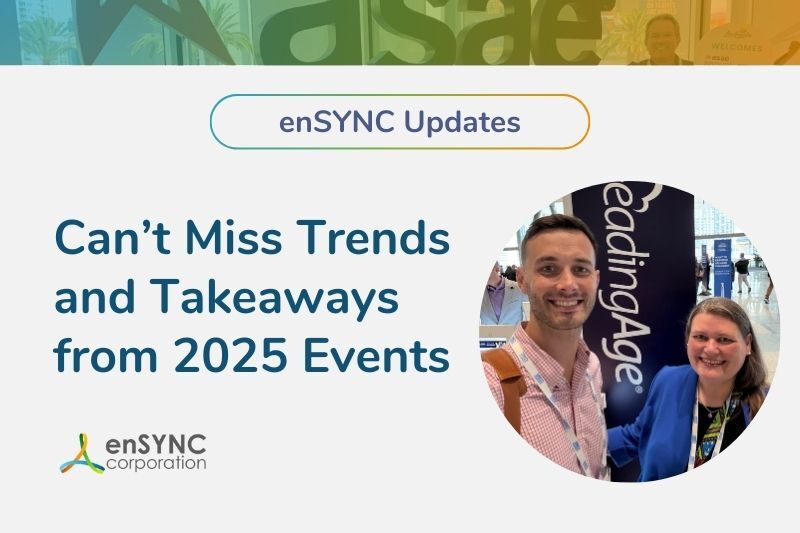Technology & digital transformation | Software solutions | Associations
Digital Transformation for Associations
August 30, 2020
|
Many associations are run in a traditional fashion because they have been working for a long time and haven’t seen a need to change, or because of a conservative board of trustees with older members who like and trust the old ways of doing things. If the business processes aren’t broken, why fix them, right?
However, this year’s health crisis and subsequent financial situation have thrown a big spanner in the works of many an association, whose well-laid plans are now moot and useless, and whose entire way of working, products and services (meetings, seminars, events) has ground to a halt because of social distancing.
It breaks our hearts to see successful professional associations, with large numbers of members and a great - albeit old fashioned - business model, suffering right now because they lack the technology and tools to respond to the times. And many managers come to us asking for help and ideas to help them persuade the board to adopt more technological solutions to be able to continue providing value to their members and raising funds for their cause.
Do you know what this time calls for?
It calls for a digital transformation.
A digital transformation is much more than using software, technology, and “the internets” - a digital transformation requires a change of mindset and a change in the culture of an association. And a digital transformation is not a fad or a newfangled theory - digital transformation strategies are vital to the survival and success of your professional organization during this crisis and going forward.
Let’s start from the top: What is a digital transformation?
What is digital transformation?
Digital transformation initiatives aim to integrate digital business, cloud computing, and technology in general into all areas of a business, through a two-pronged approach:
-
Bring the business into the digital age by integrating digital technology and automation into all key roles and aspects of the business: customer experience, supply chain, membership, relationships, etc.
-
Change the culture from within, transforming a professional society or association into an organization of independent thinkers who are constantly experimenting, thinking outside the box, and who are comfortable with failure as a path to success.
Digital technology for associations
The technology part doesn’t have to be terrifyingly advanced - big data, machine learning, digital twins, and artificial intelligence can wait. However, consider digital applications that make your work more efficient and serve your members better in the short and long term, such as:
-
Automating membership and renewal processes
-
Making your sales more efficient with an online store
-
Offering online courses, webinars, and events
-
Digitizing your bookkeeping and HR management

These are just basic applications of technology that are already being used by many national professional associations, and if you think about it for a bit there are really no excuses for clinging to spreadsheets, pen, and paper when you could be working much more efficiently:
-
There is absolutely no reason why a member of your staff should be sending renewal reminders by mail one by one when there are systems that can do it automatically.
-
There is no reason why you should stop all your events, conferences, and courses for the year when you can be delivering them over video conference.
-
There is no reason for you to miss out on merchandise sales because you cannot open your office or brick-and-mortar store when you could be selling online 24-7 to customers all over the world.
Culture transformation
The culture shift is just as important as adopting new technologies. Times have changed, and the COVID-19 crisis has accelerated and put this change in evidence, with the way everyone was suddenly forced to start doing business online.
You cannot force a digital transformation onto an association without ensuring you have buy-in from all relevant parties, from the board to the volunteers (who will probably be the most excited out of the entire organization!)
You must really sell the idea that your association has better chances of success if it’s leaner, faster, more agile - convince the team that automation is not their enemy, but a friend who will free their time so they can focus on more important tasks instead of pencil-pushing.
There will be resistance within your organization - there always is. Expert consultants agree that there are three personality types or groups of employees that either fight changes outright or drag their feet in a passive-aggressive fashion; in both cases slowing the momentum of transformation. Do not ignore them. Target them individually and bring them over to your point of view.
Old-schoolers
Older employees are likely to pooh-pooh your efforts at digital transformation, dismissing them as just another fad and refusing to get on board. They have been in the workforce a long time, trust their experience and instinct, and are often unwilling to face the discomfort of learning new technologies for fear of failing and “losing face.”
While there are many young people joining the workforce every year, studies show that employees 65 and over are actually the fastest-growing demographic in the workplace.
Consider that this is not just a large group of team members - they also have lots of experience, knowledge, and skill, and many are likely to hold high-ranking positions in the organization. Instead of making them feel forced to adopt technology, left out of discussions, or even ignored, take the time for one-on-one talks and make the learning and adoption process simpler and private, so they can see the benefits for themselves and learn to use the new technologies without “losing face”.
Stay Relevant & In Touch:
How to Use Data to Foster Long-Term Memberships and Engagement
Structured workers
There is an easily identifiable group of employees who thrive in a highly structured environment, with a clear chain of command, defined tasks, and sets of processes. This group is different from the previous one, since age is not what defines them, but rather their personality and preferences.
Keep in mind that while you and many of your employees enjoy a less structured environment, with more opportunities for taking risks and experimentation, other colleagues are more risk-averse and want to do a predictable, structured job in which the goalposts don’t move and they know precisely how to excel.
Approach these teammates with a less threatening panorama, reminding them that the goals of the organization are the same, and clarifying how performance will be evaluated. Hopefully, they will find a new structure within the digital system and be able to resume working in a way that feels safe and predictable to them.
Introverts
The more interactive nature of a digital enterprise can be too high-touch and draining for someone who just wants to do their job without so many meetings, conversations, and “let’s circle back” emails. And these team members may quietly fall through the cracks, since their silent resistance or lack of engagement will be silent and tend to go unnoticed.
It is important to keep all members of your team involved, regardless of their personality or even better, according to their personality. Do not enforce mandatory stand-up meetings or catch-ups - instead, consider other ways in which the team may communicate with one another with less personal interaction. Project management software? An online document that everyone can update and consult?
Diversity makes organizations better and more powerful, stimulates growth and creativity, and is generally a great thing. Cater to it by approaching your employees in the way that suits each of them best, so they can shine and give their all to the association.
What next?
Are you ready to tackle a digital transformation on your association? Contact us - we have materials you can use to “sell” the idea to your team, and we’ll be happy to help you pick and choose the right technology and digital solutions to seamlessly sail into the future, with grace, agility, and success.
What kind of associations management software do you need?
Take our 5 minute quiz and find out
Recent Posts

The Best of the Blog 2025 — A Year in Review
From forward-looking trend analyses to powerful case studies and thought-provoking conversations, the enSYNC blog featured a host of great content in...

Sounding Off Senior Living: What We Learned From 2025 Conversations and Events
As senior-living leaders navigate 2025’s rapid shifts in workforce, technology, regulation, and resident expectations, one theme has become...
Enjoying our blog?
At enSYNC, we want to empower associations and nonprofits to make well-educated decisions. If you want our industry knowledge (and other free guides) sent directly to your inbox, fill out the form below.



